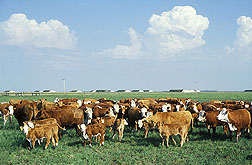To Banish Anaplasmosis
Scientists take a genetic approach to vaccine development.
|
|
With genomic maps in hand, Agricultural Research Service (ARS) and collaborating scientists at Washington State University (WSU) are plotting new strategies for fighting the bacterium Anaplasma marginale.
Mainly spread by ticks, the pathogen invades and destroys red blood cells of cattle and other ruminant hosts. Severe infections cause anemia, weight loss, abortions, and death—the latter being the fate of 50,000 to 100,000 U.S. cattle annually. Those surviving the disease (anaplasmosis) become lifelong carriers, endangering other herd members and impeding U.S. cattle trade.
Though antibiotics can kill A. marginale, a vaccine for cattle would keep the pathogen from infecting them in the first place. But besides posing safety issues, vaccination has been dogged by uneven performance. A contributing factor is A. marginale’s ability to reconfigure its surface proteins and evade detection by animals’ immune systems, says geneticist Lowell S. Kappmeyer, who’s in ARS’s Animal Diseases Research Unit (ADRU) in Pullman, Washington.
But the jig could be up, now that Kappmeyer and colleagues have the pathogen’s secret genetic playbook—its genome. The team included ADRU research leader Donald P. Knowles, WSU professors Guy H. Palmer and Travis C. McGuire, assistant professor Kelly A. Brayton, and ARS molecular biologist David R. Herndon. David L. Tibbals, research associate, and Michael J. Dark, graduate student, provided bioinformatics support.
Their first success came in 2005 when, as reported in the January 18 Proceedings of the National Academy of Sciences, the team determined the nucleic acid sequence for the St. Maries strain of A. marginale, which is carried by ticks. A second and ongoing part of the plan is sequencing the Florida strain of A. marginale, which isn’t transmissible by ticks tested thus far.
Using the approach known as “comparative genomics,” the researchers are now examining genomic components of additional strains for clues as to why one, but not the other, is transmitted by ticks. Another goal is to discover the functions of the more important of A. marginale’s 900 to 950 genes. For this, they refer to database information for several rickettsia bacteria whose genomes and gene products, such as proteins, have already been determined.
“A candidate gene thought to influence tick transmission might play a role in making certain proteins that allow A. marginale to recognize a receptor on tick cells or that produce a molecule necessary for development in the tick,” Kappmeyer says.
Identifying the critical genes is time consuming, though. Lowell estimates they’ve identified 70 percent of A. marginale’s genes so far, including those encoding for two protein superfamilies—many of which reside on the pathogen’s outer surface, where the host’s immune system searches for them.
This discovery raises the prospect of devising new vaccines that will help the host’s immune system to better recognize A. marginale’s protein-shuffling shenanigans and to flag them accordingly with antibodies that attract pathogen-eating cells, or phagocytes.
Another potential strategy is to identify and then disable specific genes called “promoters” (something like on/off switches) that facilitate the pathogen’s host-cell recognition or tick transmission. Thus weakened, the disabled pathogen could then be administered to cattle as a live, recombinant vaccine.
“That way, we would stimulate an immune response but not have to worry about the microbe reverting to virulence and spreading the disease,” says Kappmeyer.—By Jan Suszkiw, Agricultural Research Service Information Staff.
This research is part of Animal Health, an ARS National Program (#103) described on the World Wide Web at www.nps.ars.usda.gov.
Lowell S. Kappmeyer and Donald P. Knowles are in the USDA-ARS Animal Diseases Research Unit, Washington State University, Pullman, WA 99164; phone (509) 335-6059 [Kappmeyer], (509) 335-6022 [Knowles], fax (509) 335-8328.
"To Banish Anaplasmosis" was published in the February 2007 issue of Agricultural Research magazine.







